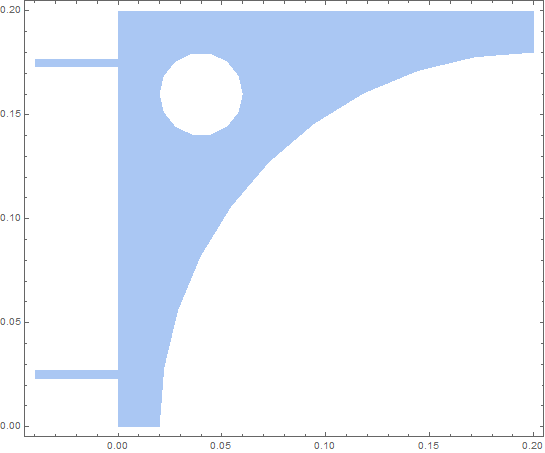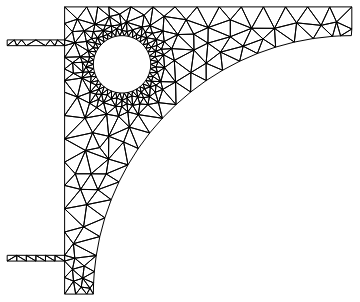I am trying to make a finite element mesh in 2D. The features are not found by ToElementMesh. This is a shelf bracket with nails. I build the region using RegionDifference and RegionUnion and the result is clear.
Needs["NDSolve`FEM`"]
L = 0.2; (* Bracket side length *)
d = 0.02; (* End edge lenght *)
r = L - d; (* radius of curved edge *)
r1 = d; (* radius of hole *)
L2 = 0.004; (* nail thickness *)
L3 = 0.04; (* nail length *)
L4 = L/8; (* location of nail from bottom *)
Y = 10^3; (* modulus of elasticity *)
ν = 33/100; (* Poisson ratio *)
reg = RegionDifference[
RegionUnion[
Rectangle[{0, 0}, {L, L}],
Rectangle[{-L3, L4 - L2/2}, {0, L4 + L2/2}],
Rectangle[{-L3, (L - L4) - L2/2}, {0, (L - L4) + L2/2}]
],
RegionUnion[
Disk[{L, 0}, r],
Disk[{2 d, L - 2 d}, r1]]
];
Show[Region[reg], PlotRange -> All, Frame -> True]

This region looks good. Now I try to mesh.
mesh = ToElementMesh[reg, "BoundaryMeshGenerator" -> "Continuation",
"MaxBoundaryCellMeasure" -> 0.001, "MaxCellMeasure" -> 0.0001];
Show[mesh["Wireframe"], PlotRange -> All]

The nails have been lost and the edges are very poorly represented. I have tried different options for ToElementMesh but have not hit on one that works. What is happening? Version 11.1 for Windows. Thanks
Edit
Helpful user21 gave a solution below which works for the resolution in his example. I have tried to increase the resolution and this is what happens.
mesh = ToElementMesh[reg, {{-0.04`, 0.2`}, {0.`, 0.2`}},
"MaxBoundaryCellMeasure" -> 0.001,
"BoundaryMeshGenerator" -> {"RegionPlot", "SamplePoints" -> 200} ];
Show[mesh["Wireframe"], PlotRange -> All]

The curved boundaries and the lower part of the vertical straight boundary are badly formed. I would like a high resolution because when doing stress calculations gradients of the solution are needed. Any more thoughts?
Combining the suggestions from the answers below is successful.
Further edit
If you use this mesh you will need to use the workaround from this question. Add the option "ImproveBoundaryPosition" -> False to ToElementMesh. The mesh coordinates are not all contained within the solution interpolation function. So the final ToElementMesh expression was
mesh = ToElementMesh[reg, {{-L3, L}, {0, L}},
"MaxBoundaryCellMeasure" -> 0.001, MaxCellMeasure -> 1.1*^-6,
AccuracyGoal -> 8, MeshQualityGoal -> 1,
"BoundaryMeshGenerator" -> {"RegionPlot", "SamplePoints" -> 200},
"ImproveBoundaryPosition" -> False];
and it worked to give this mesh








"ImproveBoundaryPosition" -> Falseoption. The geometry in this question does not show these sharp corners like the one in the linked question. When you plot(?) over the interpolating function do you use the mesh or the regionreg? $\endgroup$